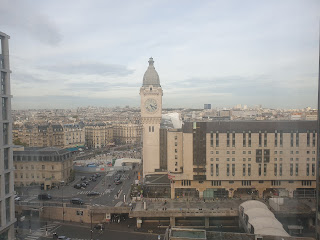Musée d'archéologie nationale - Paleolithic : archeology and artefacts
René wanted to take some better pictures and to complete the informations about early homo (Erectus, Neandertal and Sapiens).
The collection is very rich, with a focus on paleontological art. The choice of illustrations to include here is extremely difficult.
Lower paleolithic (3 million - 300'000)
Tautavel Man refers to the archaic humans which—from approximately 550,000 to 400,000 years ago—inhabited the Caune de l’Arago, a limestone cave in Tautavel, France. They are generally grouped as part of a long and highly variable lineage of transitional morphs which inhabited the Middle Pleistocene of Europe, and would eventually evolve into the Neanderthals (Homo neanderthalensis or H. sapiens neanderthalensis). They have been variably assigned to either H. (s.?) heidelbergensis, or as a European subspecies of H. erectus as H. e. tautavelensis. The skull is reconstructed based on the specimens Arago 21 and 47 (probably male), and it is, to a degree, more characteristic of what might be considered a typical H. erectus (sensu stricto) morphology than a typical H. heidelbergensis morphology. The brain capacity is 1,166 cc. They seem to have had an overall robust skeleton. Average height may have been 166 cm (5 ft 5 in).
On display earlier tools, rudimentary. Maybe fall in the category : The Clactonian is the name given by archaeologists to an industry of European flint tool manufacture that dates to the early part of the interglacial period known as the Hoxnian, the Mindel-Riss or the Holstein stages (c. 400,000 years ago). Clactonian tools were made by Homo heidelbergensis.[1].
Things are fuzzy in the literature (a long period : https://en.wikipedia.org/wiki/Acheulean).
Tautavel might be a precursor of the Neandertals. The tools on display where found at Saint-Acheul (which gave th name to the industry, but that period extends back to 1.5 million year<s ago in Africa.
https://www.britannica.com/event/Stone-Age/Middle-Paleolithic
Middle paleolithic (300'000-40'000/30'000)
Levallois technique,which is part of the Mousterian stone tool industry with beautiful artefacts.(stones and flints and bones used to sharpen the stone tools. At La Quina (and i French, much more extensive) site, they found a Neanderthal female (at least her bones ;-) and a 8 years old boy.



Comments
Post a Comment